The Cambridge History of Japan, Vol. 4: Early Modern Japan
Подождите немного. Документ загружается.

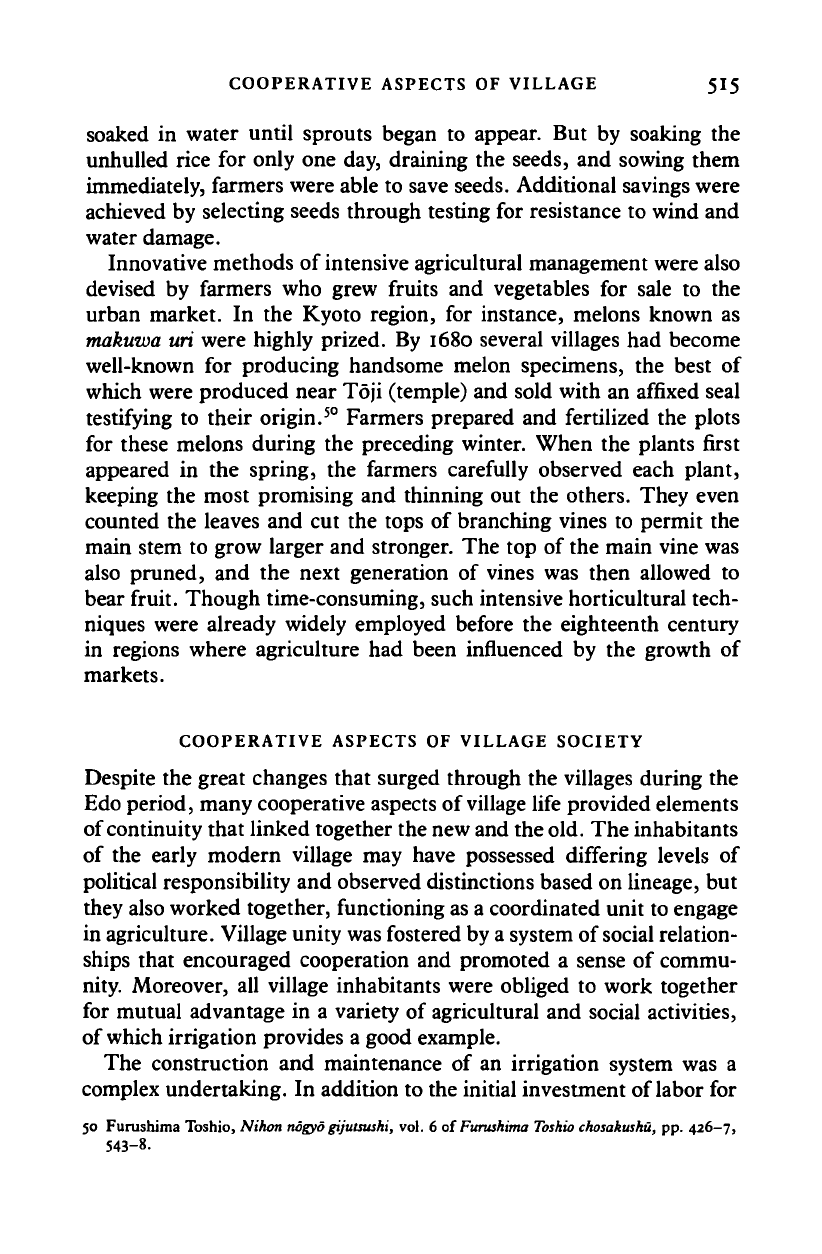
COOPERATIVE ASPECTS OF VILLAGE 515
soaked in water until sprouts began to appear. But by soaking the
unhulled rice for only one day, draining the seeds, and sowing them
immediately, farmers were able to save seeds. Additional savings were
achieved by selecting seeds through testing for resistance to wind and
water damage.
Innovative methods of intensive agricultural management were also
devised by farmers who grew fruits and vegetables for sale to the
urban market. In the Kyoto region, for instance, melons known as
makuwa
uri were highly prized. By 1680 several villages had become
well-known for producing handsome melon specimens, the best of
which were produced near Toji (temple) and sold with an affixed seal
testifying to their origin.
50
Farmers prepared and fertilized the plots
for these melons during the preceding winter. When the plants first
appeared in the spring, the farmers carefully observed each plant,
keeping the most promising and thinning out the others. They even
counted the leaves and cut the tops of branching vines to permit the
main stem to grow larger and stronger. The top of the main vine was
also pruned, and the next generation of vines was then allowed to
bear fruit. Though time-consuming, such intensive horticultural tech-
niques were already widely employed before the eighteenth century
in regions where agriculture had been influenced by the growth of
markets.
COOPERATIVE ASPECTS OF VILLAGE SOCIETY
Despite the great changes that surged through the villages during the
Edo period, many cooperative aspects of
village
life provided elements
of continuity that linked together the new and the old. The inhabitants
of the early modern village may have possessed differing levels of
political responsibility and observed distinctions based on lineage, but
they also worked together, functioning as a coordinated unit to engage
in agriculture. Village unity was fostered by a system of
social
relation-
ships that encouraged cooperation and promoted a sense of commu-
nity. Moreover, all village inhabitants were obliged to work together
for mutual advantage in a variety of agricultural and social activities,
of which irrigation provides a good example.
The construction and maintenance of an irrigation system was a
complex undertaking. In addition to the initial investment of labor for
50 Furushima Toshio, Nikon
nogyo
gijutsushi,
vol. 6 of
Furushima Toshio
chosakushu,
pp. 426-7,
543-8.
Cambridge Histories Online © Cambridge University Press, 2008
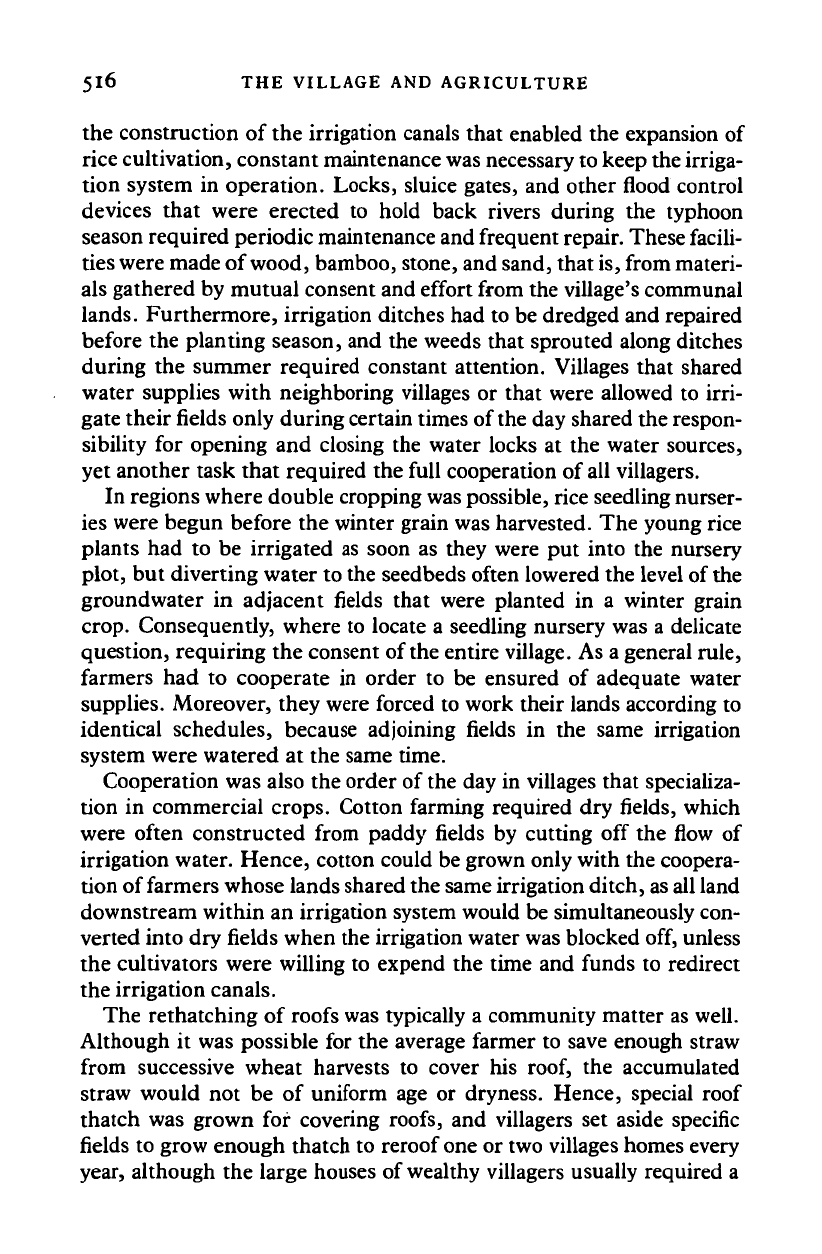
5l6 THE VILLAGE AND AGRICULTURE
the construction
of
the irrigation canals that enabled the expansion
of
rice cultivation, constant maintenance was necessary to keep the irriga-
tion system
in
operation. Locks, sluice gates,
and
other flood control
devices that were erected
to
hold back rivers during
the
typhoon
season required periodic maintenance and frequent repair. These facili-
ties were made of wood, bamboo, stone, and sand, that
is,
from materi-
als gathered by mutual consent and effort from the village's communal
lands.
Furthermore, irrigation ditches had to be dredged and repaired
before the planting season, and the weeds that sprouted along ditches
during
the
summer required constant attention. Villages that shared
water supplies with neighboring villages
or
that were allowed
to
irri-
gate their fields only during certain times of the day shared the respon-
sibility
for
opening
and
closing
the
water locks
at the
water sources,
yet another task that required the full cooperation
of
all villagers.
In regions where double cropping was possible, rice seedling nurser-
ies were begun before the winter grain was harvested. The young rice
plants
had to be
irrigated
as
soon
as
they were
put
into
the
nursery
plot, but diverting water to the seedbeds often lowered the level of the
groundwater
in
adjacent fields that were planted
in a
winter grain
crop.
Consequently, where
to
locate
a
seedling nursery was
a
delicate
question, requiring the consent of the entire village. As a general rule,
farmers
had to
cooperate
in
order
to be
ensured
of
adequate water
supplies. Moreover, they were forced to work their lands according
to
identical schedules, because adjoining fields
in the
same irrigation
system were watered
at
the same time.
Cooperation was also the order
of
the day
in
villages that specializa-
tion
in
commercial crops. Cotton farming required
dry
fields, which
were often constructed from paddy fields
by
cutting
off
the flow
of
irrigation water. Hence, cotton could be grown only with the coopera-
tion of farmers whose lands shared the same irrigation ditch, as all land
downstream within
an
irrigation system would be simultaneously con-
verted into dry fields when the irrigation water was blocked
off,
unless
the cultivators were willing
to
expend
the
time
and
funds
to
redirect
the irrigation canals.
The re thatching
of
roofs was typically
a
community matter as well.
Although
it
was possible
for the
average farmer
to
save enough straw
from successive wheat harvests
to
cover
his
roof,
the
accumulated
straw would
not be of
uniform
age or
dryness. Hence, special roof
thatch
was
grown
for
covering roofs,
and
villagers
set
aside specific
fields to grow enough thatch to reroof one or two villages homes every
year, although the large houses of wealthy villagers usually required
a
Cambridge Histories Online © Cambridge University Press, 2008
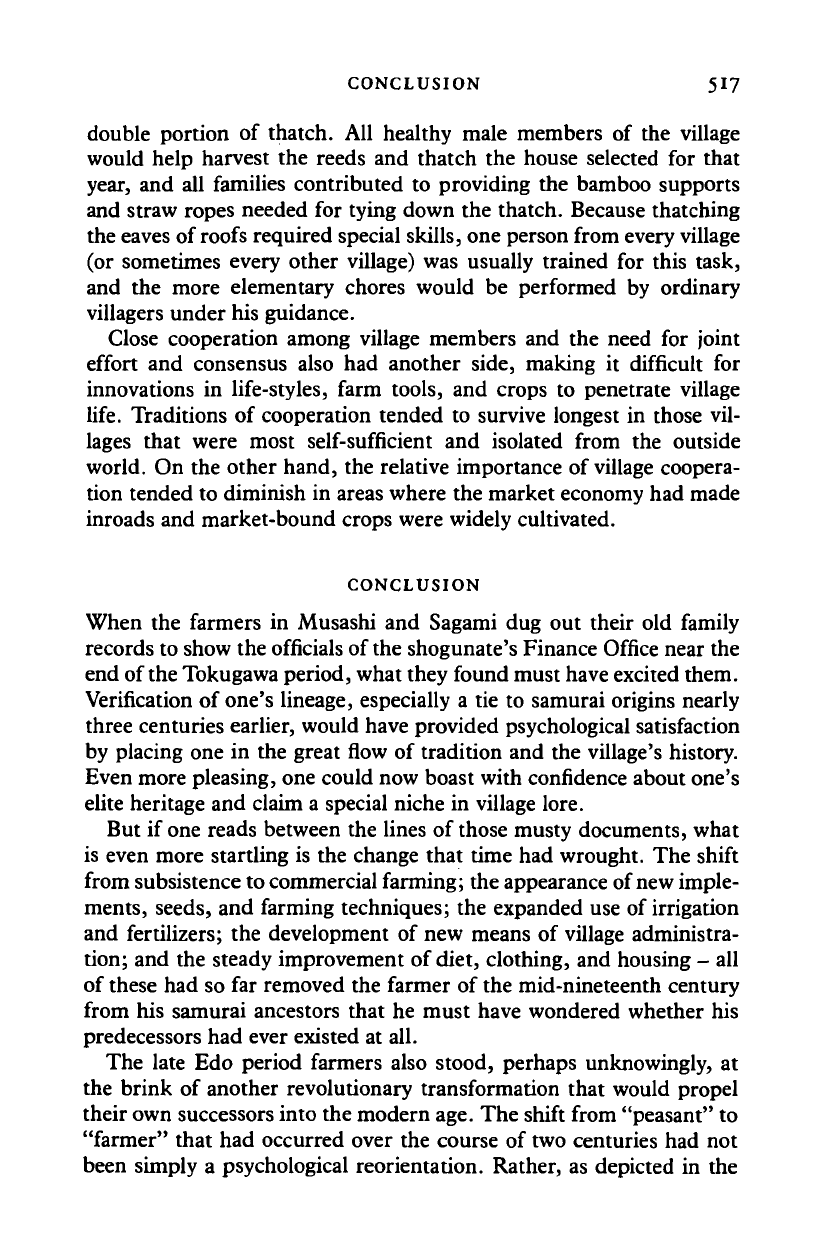
CONCLUSION 517
double portion of thatch. All healthy male members of the village
would help harvest the reeds and thatch the house selected for that
year, and all families contributed to providing the bamboo supports
and straw ropes needed for tying down the thatch. Because thatching
the eaves of roofs required special skills, one person from every village
(or sometimes every other village) was usually trained for this task,
and the more elementary chores would be performed by ordinary
villagers under his guidance.
Close cooperation among village members and the need for joint
effort and consensus also had another side, making it difficult for
innovations in life-styles, farm tools, and crops to penetrate village
life.
Traditions of cooperation tended to survive longest in those vil-
lages that were most self-sufficient and isolated from the outside
world. On the other hand, the relative importance of village coopera-
tion tended to diminish in areas where the market economy had made
inroads and market-bound crops were widely cultivated.
CONCLUSION
When the farmers in Musashi and Sagami dug out their old family
records to show the officials of the shogunate's Finance Office near the
end of
the
Tokugawa period, what they found must have excited them.
Verification of one's lineage, especially a tie to samurai origins nearly
three centuries earlier, would have provided psychological satisfaction
by placing one in the great flow of tradition and the village's history.
Even more pleasing, one could now boast with confidence about one's
elite heritage and claim a special niche in village lore.
But if one reads between the lines of those musty documents, what
is even more startling is the change that time had wrought. The shift
from subsistence to commercial farming; the appearance of new imple-
ments, seeds, and farming techniques; the expanded use of irrigation
and fertilizers; the development of new means of village administra-
tion; and the steady improvement of diet, clothing, and housing - all
of these had so far removed the farmer of the mid-nineteenth century
from his samurai ancestors that he must have wondered whether his
predecessors had ever existed at all.
The late Edo period farmers also stood, perhaps unknowingly, at
the brink of another revolutionary transformation that would propel
their own successors into the modern age. The shift from "peasant" to
"farmer" that had occurred over the course of two centuries had not
been simply a psychological reorientation. Rather, as depicted in the
Cambridge Histories Online © Cambridge University Press, 2008
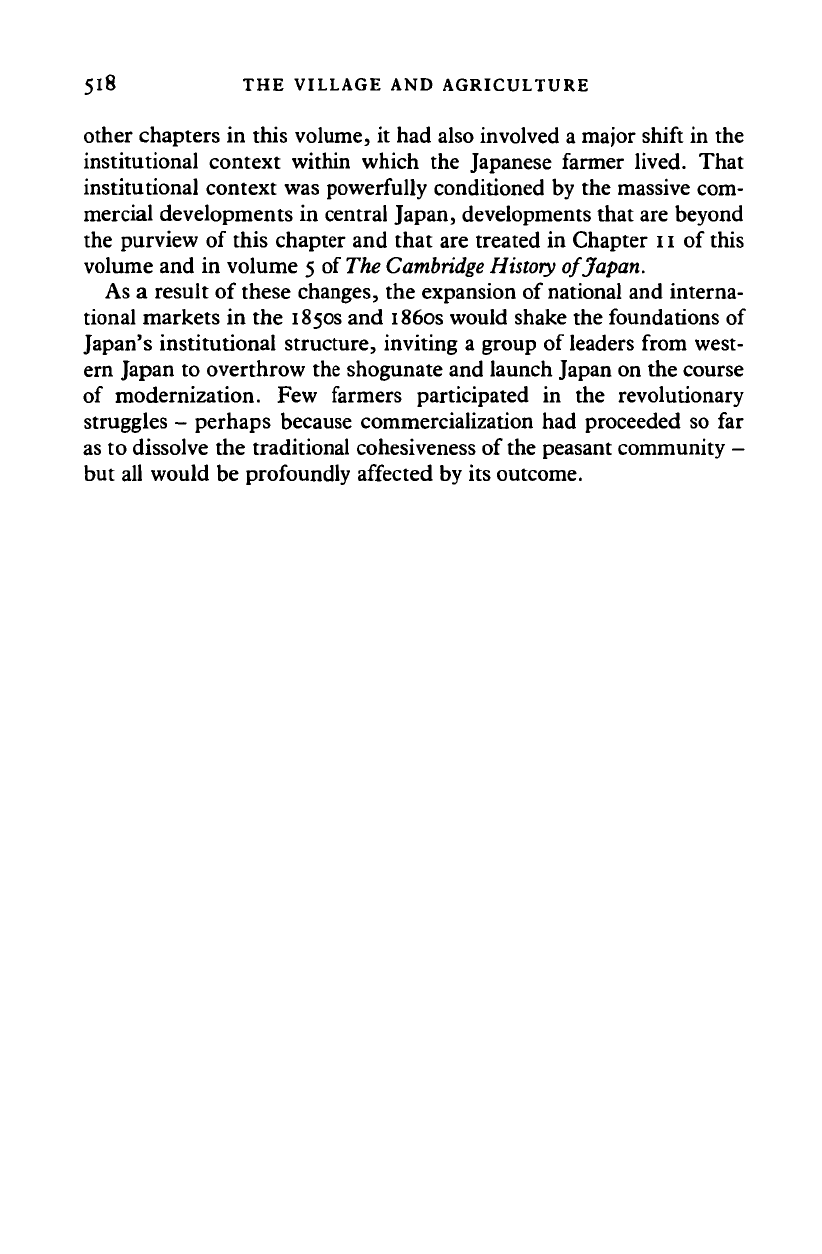
5l8 THE VILLAGE AND AGRICULTURE
other chapters
in
this volume,
it
had also involved
a
major shift
in the
institutional context within which
the
Japanese farmer lived. That
institutional context was powerfully conditioned
by
the massive com-
mercial developments
in
central Japan, developments that are beyond
the purview
of
this chapter
and
that
are
treated
in
Chapter 11
of
this
volume and
in
volume 5
of
The
Cambridge History
of Japan.
As
a
result
of
these changes, the expansion
of
national
and
interna-
tional markets
in the
1850s and 1860s would shake the foundations of
Japan's institutional structure, inviting
a
group
of
leaders from west-
ern Japan
to
overthrow the shogunate and launch Japan on the course
of modernization.
Few
farmers participated
in the
revolutionary
struggles
-
perhaps because commercialization
had
proceeded
so far
as
to
dissolve
the
traditional cohesiveness
of
the peasant community
-
but all would be profoundly affected by its outcome.
Cambridge Histories Online © Cambridge University Press, 2008
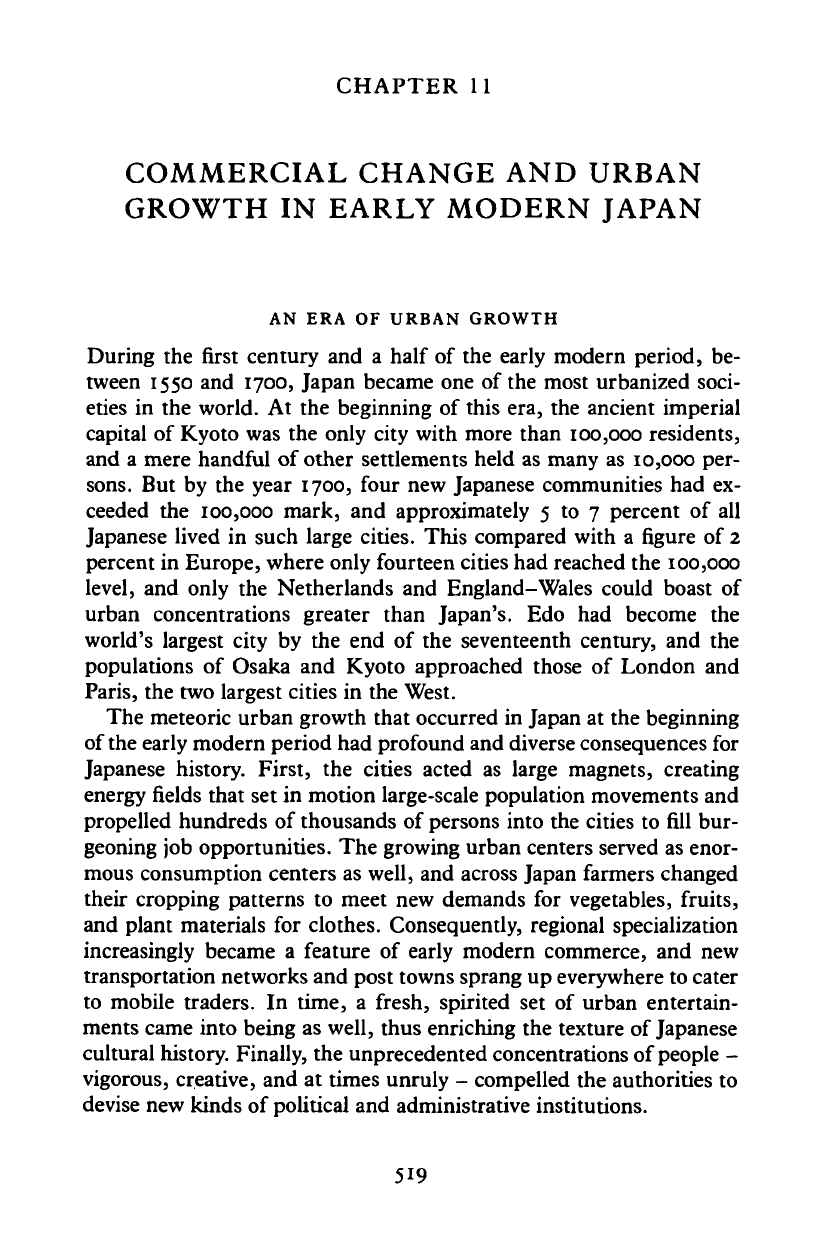
CHAPTER 11
COMMERCIAL CHANGE AND URBAN
GROWTH IN EARLY MODERN JAPAN
AN ERA OF URBAN GROWTH
During the first century and a half of the early modern period, be-
tween 1550 and 1700, Japan became one of the most urbanized soci-
eties in the world. At the beginning of this era, the ancient imperial
capital of Kyoto was the only city with more than 100,000 residents,
and a mere handful of other settlements held as many as 10,000 per-
sons.
But by the year 1700, four new Japanese communities had ex-
ceeded the 100,000 mark, and approximately 5 to 7 percent of all
Japanese lived in such large cities. This compared with a figure of 2
percent in Europe, where only fourteen cities had reached the 100,000
level, and only the Netherlands and England-Wales could boast of
urban concentrations greater than Japan's. Edo had become the
world's largest city by the end of the seventeenth century, and the
populations of Osaka and Kyoto approached those of London and
Paris,
the two largest cities in the West.
The meteoric urban growth that occurred in Japan at the beginning
of
the
early modern period had profound and diverse consequences for
Japanese history. First, the cities acted as large magnets, creating
energy fields that set in motion large-scale population movements and
propelled hundreds of thousands of persons into the cities to fill bur-
geoning job opportunities. The growing urban centers served as enor-
mous consumption centers as well, and across Japan farmers changed
their cropping patterns to meet new demands for vegetables, fruits,
and plant materials for clothes. Consequently, regional specialization
increasingly became a feature of early modern commerce, and new
transportation networks and post towns sprang up everywhere to cater
to mobile traders. In time, a fresh, spirited set of urban entertain-
ments came into being as well, thus enriching the texture of Japanese
cultural history. Finally, the unprecedented concentrations of people -
vigorous, creative, and at times unruly - compelled the authorities to
devise new kinds of political and administrative institutions.
519
Cambridge Histories Online © Cambridge University Press, 2008

520 COMMERCIAL CHANGE AND URBAN GROWTH
The Sengoku period background
The quest to understand how and why this urban growth took place,
and to appreciate as well the historical significance of the cities, takes
us back in time to the middle of the sixteenth century - to the
Sengoku period and the genesis of Japan's extraordinary epoch of
urban development.
1
There were three principal types of urban settle-
ment at that time. The most common, and the seed of what ultimately
would become the dominant urban force in the early modern period in
Japan, was the castle town, or
jokamachi,
literally a community that
grew up around a castle. During the first half of the sixteenth century,
the bushi tended to live in agricultural villages, where they managed
their fiefs and the affairs of the villagers. Gradually, during the de-
cades of continual warfare that marked this era, these bushi emerged
as an elite, arms-bearing class. As this happened, their leaders began
to move out of the villages and to establish fortified residences at more
easily defended locations. As revealed in names such as Negoya (liter-
ally, the huts at the base of the mountain) and Yamashita (at the foot of
the mountain), these strongholds were usually situated where plains
meet mountains, and they provided assembly points where, in times of
crisis,
the lord could gather his military band of retainers, relatives,
and vassal samurai.
2
These military centers quickly came to be the home for civilians as
well. As combat spread into even remote parts of the country during
the later decades of the sixteenth century, the castellans (now more
familiarly known as daimyo), found it advantageous to gather into
their castle headquarters larger and larger numbers of artisans who
could manufacture weapons such as swords, lances, and even fire-
arms;
merchants who could transport these goods; and
finally,
groups
of laborers to work on construction projects. It was also useful for the
daimyo to establish within the precincts of the new castle towns offi-
cially authorized marketplaces where commodity transactions could
1 For a convenient overview of the issues that have occupied the attention of historians concern-
ing Sengoku period cities, see Nakabe Yoshiko, "Sengoku jidai daimyo kyoju toshi ni kansuru
shomondai," in Chihoshi kenkyu kyogikai, ed.,
Toshi
no
chihoshi
(Tokyo: Yusankaku, 1980),
pp.
56-79. In English, see Haruko Wakita, with Susan B. Hanley, "Dimensions of Develop-
ment: Cities in Fifteenth-Century Japan," in John Whitney Hall, Keiji Nagahara, and Kozo
Yamamura, eds., Japan Before
Tokugawa:
Political
Consolidation
and
Economic
Growth, 1500-
/650 (Princeton, N.J.: Princeton University Press, 1981), pp. 295-326.
2 Nishikawa Koji, Nihon toshishi no kenkyu (Tokyo: Nihon hoso shuppan kyokai, 1972), pp.
167-202.
Cambridge Histories Online © Cambridge University Press, 2008

AN ERA OF URBAN GROWTH 521
take place peacefully, and this too encouraged permanent residence in
the towns.
3
As the daimyo's policies gave rise to larger and more prosperous
communities, the towns also became centers of local religious and
cultural activities. Moreover, as life in the imperial capital of Kyoto
became less secure after the Onin War (1467-77), men of artistic and
literary accomplishment, such as the landscape artist and garden de-
signer Sesshu, left the capital and took refuge in the provinces. And
like Sesshu, who was employed by the Ouchi daimyo of western Ja-
pan, such persons often were taken into service by the daimyo, thus
ultimately bringing a measure of cultural refinement to the lives of the
bushi and cementing the tie between artist and military figures that
would endure into the early modern period.
Some notion of the vitality of these communities can be found in the
epistles of the Jesuit missionaries, who openly admired the castle
towns of the Sengoku period.
4
When visiting Gifu in 1575, for in-
stance, Luis Frois wrote: "At this point I wish I were a skilled archi-
tect or had the gift of describing places well, because I sincerely assure
you that of all the palaces and houses I have seen in Portugal, India,
and Japan, there has been nothing to compare with this as regards
luxury, wealth, and cleanliness." And after visiting Azuchi in 1584,
Louren§o Mexia remarked that Japanese houses were as neat and clean
as sacristies and that at Nobunaga's palace "the gardens and corridors
were such that one could not spit in them." Such praise, however,
should not obscure the fact that these castle towns were still relatively
small; even in the 1580s most had populations of only a few thousand
persons. Still, more than a hundred such settlements dotted the coun-
tryside of Japan, and these would provide one of the seedbeds for the
rapid urbanization of the seventeenth century, growth that would pro-
pel Japan into the leading ranks of the urbanized countries.
Although these rustic castle towns represented the principal urban
creation of the late Sengoku period, they were not without competi-
tors.
The warfare of that age was fought at two different levels. The
first and most visible was the struggle among daimyo to expand their
domains by military means; the other was the contest for supremacy
within domains between individual daimyo and armed elements of the
peasantry. In some instances, groups of such peasants were members
3 Nakabe Yoshiko,
Jokamachi
(Kyoto:
Yanagihara shoten, 1978), pp. 9-64.
4 Michael Cooper, ed.,
They Came
to
Japan:
An
Anthology
of
European Reports
on Japan, 1543-
1640
(Berkeley and Los Angeles: University of California Press, 1965), pp. 131, 145.
Cambridge Histories Online © Cambridge University Press, 2008

522 COMMERCIAL CHANGE AND URBAN GROWTH
of secularly powerful Buddhist sects, such as the Ikko, or True Pure
Land sect
(Jodo
Shinshu), which permitted the peasants, together with
merchants and artisans who were also sect members, to take up resi-
dence in and around a sect temple. These settlements then became
known as "temple towns" (jinaimachi), and their residents often
claimed autonomy from daimyo control.
5
These temple towns were distinct from the so-called
monzenmachi
(literally, towns in front of the gates), which were concentrations of
inns and souvenir shops clustered together around the entrances to
those famous shrines and temples that attracted large numbers of
worshipers and pilgrims.
6
The essential difference between the two
urban types is that the temple towns formed under the auspices of
major temples had a distinctive religious character and asserted their
independence from the daimyo's authority. That is, these communi-
ties as corporate groups exercised judicial and police powers, appor-
tioned and at times even levied their own tax dues, and undertook
self-
defense projects such as the construction of
moats.
The possession of
these special immunities permitted the temple towns to carry out cer-
tain functions outside the direct purview of
daimyo
authority, and it is
this latitude for independent action that has prompted historians to see
them as autonomous, self-governing communities.
7
Historians have identified seventeen temple towns, all founded in the
middle decades of the sixteenth century.
8
These settlements, however,
tended to have very short life
spans.
As
daimyo put together greater and
greater concentrations of military and political might during the latter
half of the sixteenth century, they attacked the major religious sects and
cut away the independent power basis of the temple towns. In some
cases,
the daimyo actually converted the temple towns into their own
castle headquarters. For instance, Osaka was known at that time as
Ishiyama and was built up as an armed community of Honganji believ-
ers.
In 1580, Oda Nobunaga destroyed this fortified town after
a
decade
of fighting, and subsequently Toyotomi Hideyoshi erected his own
5 The term is also read as
jinaicho.
A good introduction to this type of settlement can be found in
Wakita Osamu, "Jinaimachi no kozo to tenkai,"
Shirin 41
(January 1958): 1-24.
6 Harada Tomohiko, "Kinsei no monzenmachi," in Toyoda Takeshi, Harada Tomohiko, and
Yamori Kazuhiko, eds., Koza: Nihon
no hoken
loshi,
3 vols. (Tokyo: Bun'ichi sogo shuppan,
1981-2), vol. 3, pp. 201-23.
7 In certain
jinaimachi
the temple priests retained ultimate political authority and managed the
affairs of the community. See Osamu Wakita, with James L. McClain, "The Commercial and
Urban Policies of Oda Nobunaga and Toyotomi Hideyoshi," in Hall, Nagahara, and Yama-
mura, eds., Japan
Before
Tokugawa,
pp. 231-7.
8 For a careful discussion of the origins of temple towns and their historical significance, see
Wakita Osamu, "Jinaimachi no rekishi-teki tokushitsu," in Toyoda, Harada, and Yamori,
eds.,
Koza: Nihon
no hoken
wshi,
vol. 1, pp. 143-64.
Cambridge Histories Online © Cambridge University Press, 2008
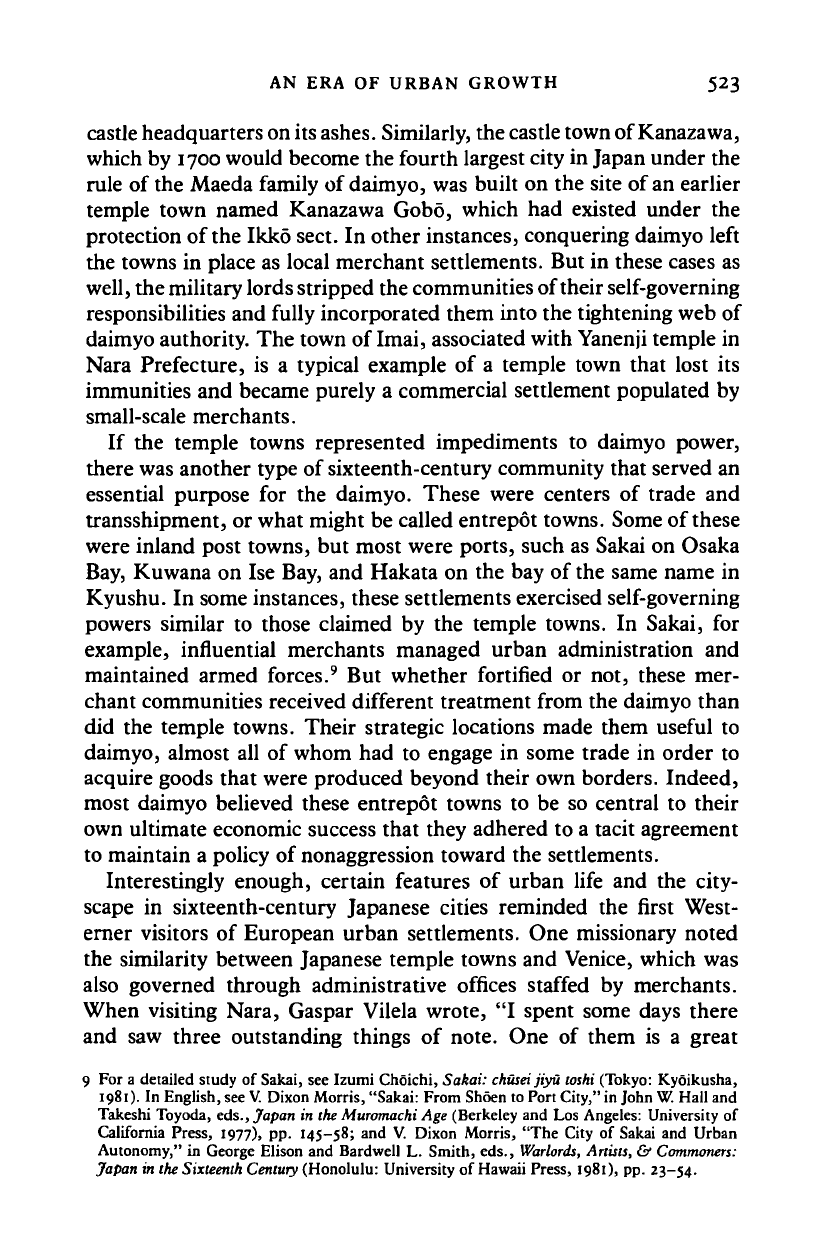
AN ERA OF URBAN GROWTH 523
castle
headquarters on its
ashes.
Similarly, the castle town of Kanazawa,
which by
1700
would become the fourth largest city in Japan under the
rule of the Maeda family of
daimyo,
was built on the site of an earlier
temple town named Kanazawa Gobo, which had existed under the
protection of the Ikko sect. In other instances, conquering daimyo left
the towns in place as local merchant settlements. But in these cases as
well, the military lords stripped the communities of their self-governing
responsibilities and fully incorporated them into the tightening web of
daimyo authority. The town of
Imai,
associated with Yanenji temple in
Nara Prefecture, is a typical example of a temple town that lost its
immunities and became purely a commercial settlement populated by
small-scale merchants.
If the temple towns represented impediments to daimyo power,
there was another type of sixteenth-century community that served an
essential purpose for the daimyo. These were centers of trade and
transshipment, or what might be called entrepot towns. Some of these
were inland post towns, but most were ports, such as Sakai on Osaka
Bay, Kuwana on Ise Bay, and Hakata on the bay of the same name in
Kyushu. In some instances, these settlements exercised self-governing
powers similar to those claimed by the temple towns. In Sakai, for
example, influential merchants managed urban administration and
maintained armed forces.
9
But whether fortified or not, these mer-
chant communities received different treatment from the daimyo than
did the temple towns. Their strategic locations made them useful to
daimyo, almost all of whom had to engage in some trade in order to
acquire goods that were produced beyond their own borders. Indeed,
most daimyo believed these entrepot towns to be so central to their
own ultimate economic success that they adhered to a tacit agreement
to maintain a policy of nonaggression toward the settlements.
Interestingly enough, certain features of urban life and the city-
scape in sixteenth-century Japanese cities reminded the first West-
erner visitors of European urban settlements. One missionary noted
the similarity between Japanese temple towns and Venice, which was
also governed through administrative offices staffed by merchants.
When visiting Nara, Gaspar Vilela wrote, "I spent some days there
and saw three outstanding things of note. One of them is a great
9 For a detailed study of Sakai, see Izumi Choichi, Sakai: chuseijiyu
toshi
(Tokyo: Kyoikusha,
1981).
In English, see
V.
Dixon Morris, "Sakai: From Shoen to Port
City,"
in John
W.
Hall and
Takeshi Toyoda, eds., Japan in the
Muromachi
Age (Berkeley and Los Angeles: University of
California Press, 1977), pp. 145-58; and V. Dixon Morris, "The City of Sakai and Urban
Autonomy," in George Elison and Bardwell L. Smith, eds.,
Warlords,
Artists, &
Commoners:
Japan in
the Sixteenth Century
(Honolulu: University of Hawaii Press, 1981), pp. 23-54.
Cambridge Histories Online © Cambridge University Press, 2008
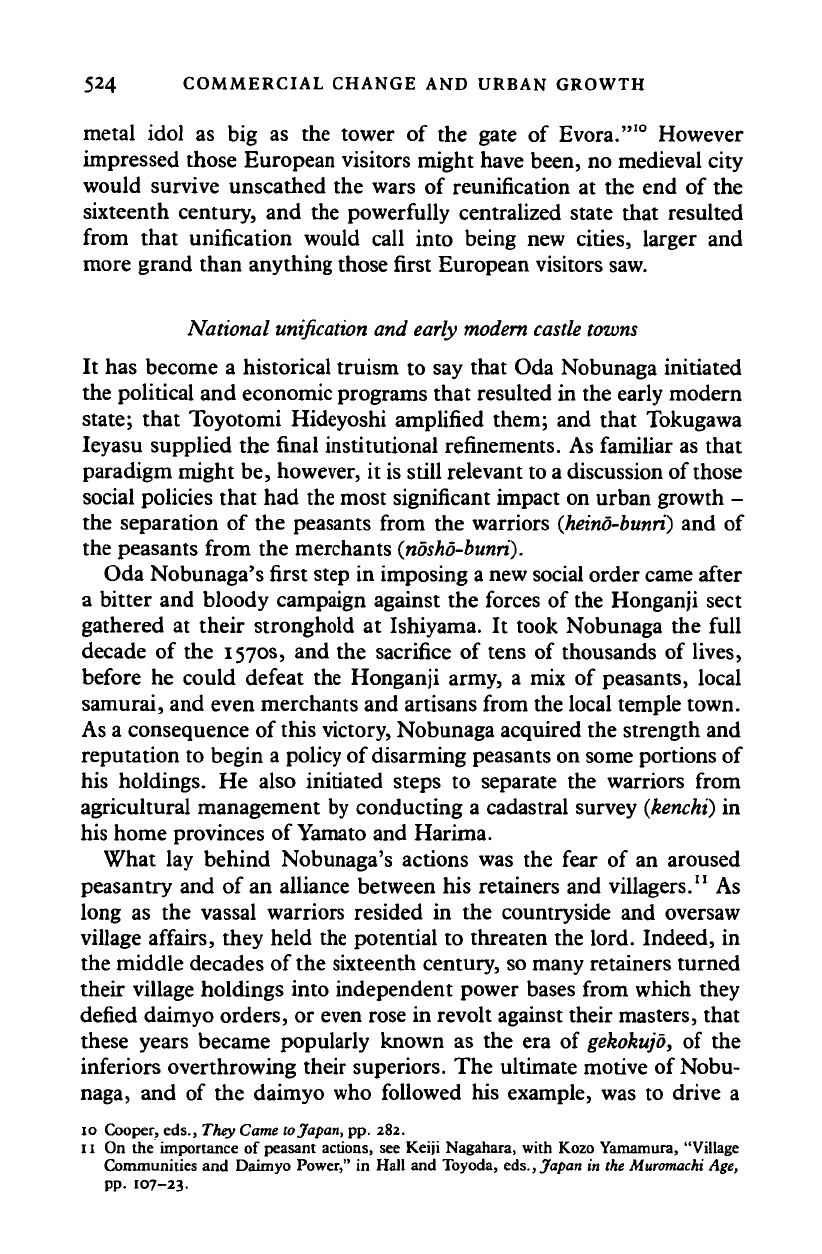
524 COMMERCIAL CHANGE AND URBAN GROWTH
metal idol as big as the tower of the gate of Evora."
10
However
impressed those European visitors might have been, no medieval city
would survive unscathed the wars of reunification at the end of the
sixteenth century, and the powerfully centralized state that resulted
from that unification would call into being new cities, larger and
more grand than anything those first European visitors saw.
National
unification
and early
modern castle
towns
It has become a historical truism to say that Oda Nobunaga initiated
the political and economic programs that resulted in the early modern
state;
that Toyotomi Hideyoshi amplified them; and that Tokugawa
Ieyasu supplied the final institutional refinements. As familiar as that
paradigm might be, however, it is still relevant to a discussion of those
social policies that had the most significant impact on urban growth -
the separation of the peasants from the warriors
(heino-bunri)
and of
the peasants from the merchants
(nosho-bunri).
Oda Nobunaga's first step in imposing a new social order came after
a bitter and bloody campaign against the forces of the Honganji sect
gathered at their stronghold at Ishiyama. It took Nobunaga the full
decade of the 1570s, and the sacrifice of tens of thousands of lives,
before he could defeat the Honganji army, a mix of peasants, local
samurai, and even merchants and artisans from the local temple town.
As a consequence of this victory, Nobunaga acquired the strength and
reputation to begin a policy of disarming peasants on some portions of
his holdings. He also initiated steps to separate the warriors from
agricultural management by conducting a cadastral survey
(kenchi)
in
his home provinces of Yamato and Harima.
What lay behind Nobunaga's actions was the fear of an aroused
peasantry and of an alliance between his retainers and villagers.
11
As
long as the vassal warriors resided in the countryside and oversaw
village affairs, they held the potential to threaten the lord. Indeed, in
the middle decades of the sixteenth century, so many retainers turned
their village holdings into independent power bases from which they
defied daimyo orders, or even rose in revolt against their masters, that
these years became popularly known as the era of
gekokujo,
of the
inferiors overthrowing their superiors. The ultimate motive of Nobu-
naga, and of the daimyo who followed his example, was to drive a
10 Cooper, eds., They Came to Japan, pp. 282.
11 On the importance of peasant actions, see Keiji Nagahara, with Kozo Yamamura, "Village
Communities and Daimyo Power," in Hall and Toyoda, eds., Japan in the
Muromachi
Age,
pp.
107-23.
Cambridge Histories Online © Cambridge University Press, 2008
